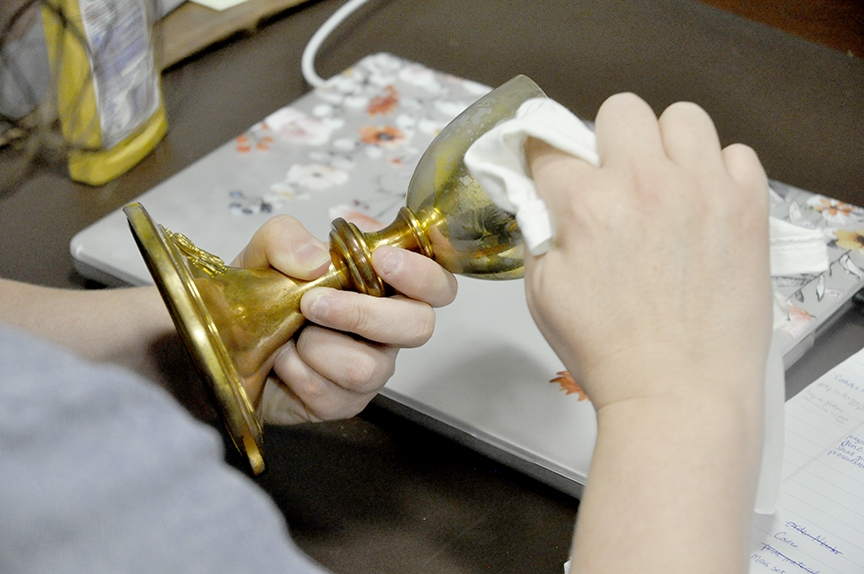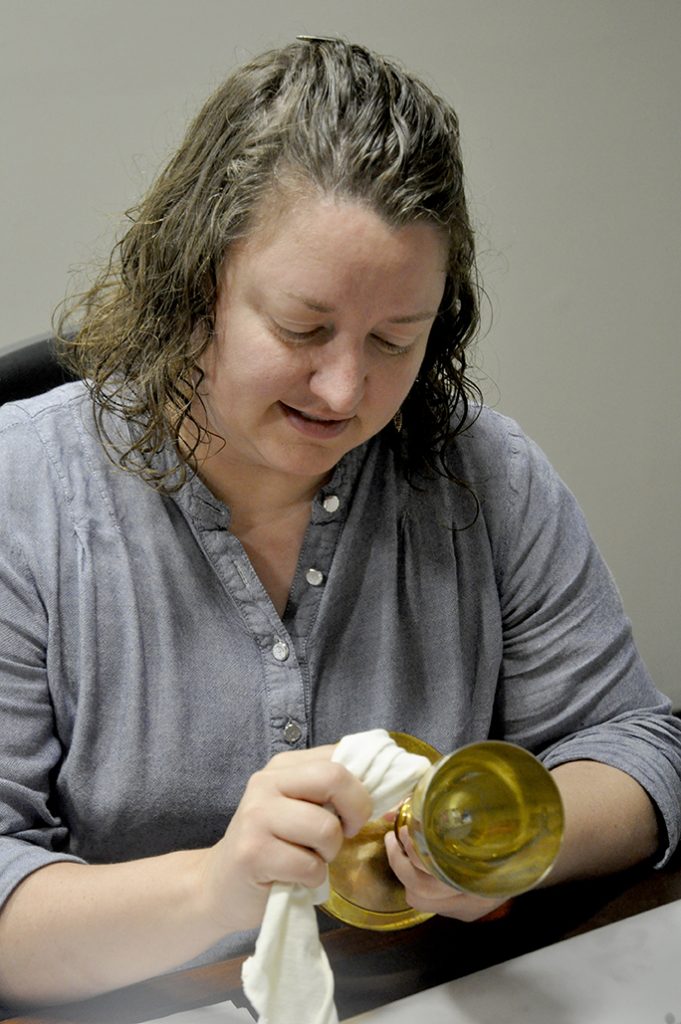
The Eucharist is the source and summit of the Christian life, which is why the vessels used as the receptacles of the very body, blood, soul, and divinity of Christ must be properly blessed, used, cleaned, and maintained with great care.
“Among the requisites for the celebration of Mass, the sacred vessels are held in special honor, and among these especially the chalice and paten, in which the bread and wine are offered and consecrated and from which they are consumed,” according to “The General Instruction of the Roman Missal.” “Sacred vessels should be made from precious metal. If they are made from metal that rusts or from a metal less precious than gold, they should generally be gilded on the inside.
“In the Diocese of the United States of America, sacred vessels may also be made from other solid materials which in the common estimation in each region are considered precious or noble, for example, ebony or other harder woods, provided that such materials are suitable for sacred use. This applies to all vessels that are intended to hold the hosts, such as the paten, the ciborium, the pyx, the monstrance and other kinds of things,” it continued. “As regards chalices and other vessels that are intended to serve as receptacles for the Blood of the Lord, they are to have a bowl of material that does not absorb liquids. The base, on the other hand, may be made of other solid and worthy materials.”
Such is the case for the more than 40 vessels recently discovered and unpacked in the Diocese of Nashville archives.
Blessing the vessels
For a vessel to become sacred and used in the sacrifice of the Mass, certain steps have to be taken, according to the Roman Missal.
According to paragraph 35, “Before being used, vessels for the celebration must be blessed by the bishop or priest according to the ‘Rite of Blessing a Chalice and Paten.’”
According to the rite, “Since the chalice and paten are used for the offering and consecration of the bread and wine and for communion, they are reserved exclusively and permanently for the celebration of the Eucharist, and so become ‘sacred vessels.’ The intention of reserving these vessels exclusively for the celebration of the Eucharist is made manifest before the community of the faithful by a special blessing, which is appropriate to impart during Mass.”
The ritual is usually reserved for after the homily, during which the celebrant not only explains the readings but also “the meaning of the blessing of a chalice and paten that are used in the celebration of the Lord’s Supper.”
Once the vessels are placed on the altar by the presenting members of the community, the following antiphone is sung: “The chalice of salvation I will raise, and I will call on the name of the Lord.”
Once the singing concludes, the priest prays: “With joy, Lord God, we place on your altar this chalice and paten for the celebration of the sacrifice of the new covenant: may the Body and Blood of your Son, offered and received by means of these vessels, make them holy. Grant, we pray, O Lord, that, celebrating the unblemished sacrifice, we may be renewed by your Sacraments on earth and endowed with your Spirit, until with the Saints we come to delight in your banquet in the Kingdom of Heaven. Glory and honor to you forever.”
Upon this conclusion of the prayer, the corporal is placed on the altar and the gifts are presented and offered as normal, all while another antiphon is sung “The chalice of salvation I will raise, and I will offer a sacrifice of praise,” followed by the singing of Psalm 115, with the same antiphon repeated between verses.
Cleaning the vessels

There is a special process in which vessels have to be cleaned during and after the celebration of the Mass.
According to paragraph 279, “the sacred vessels are purified by the priest, the deacon, or an instituted acolyte after Communion or after Mass, in so far as possible at the credence table. The purification of the chalice is done with water alone or with wine and water, which is then consumed by whoever does the purification. The paten is wiped clean as usual with the purificator. Care is to be taken that whatever may remain of the Blood of Christ after the distribution of Communion is consumed immediately and completely at the altar.”
Once this ritual purification is done, “vessels would usually be washed after in the sacristy using the sacrarium (or sink), usually by a sacristan, but the initial ceremonial purification must take place first,” added Father John Hammond, vicar general and judicial vicar for the Diocese of Nashville, and pastor of St. Patrick Church in South Nashville.
Maintaining the vessels
As these rituals help fulfill the requirement of holding the sacred vessels in the highest esteem, it also includes the process of maintaining their beauty and quality. It’s something Kristen Rainey, assistant director of Marriage and Family for the diocese’s Office of Faith Formation, has volunteered to help with as more of these vessels are brought out of the archives. It is a skill she learned during her time in the convent as she discerned religious life.
“It’s important to care for sacred vessels well because of their purpose,” Rainey said. “This is how we receive the Lord, so we want to give them our best and treat the sacred with solemnity.”
“What’s nice about cleaning them is, for me, it’s an act of devotion to the Eucharist because these vessels are going to hold the body and blood of the Lord, so we want them to be in the best condition they can be to reverence the Blessed Sacrament,” she added. “My desire in cleaning them is more like an act of worship for the Eucharist … and, in a way, it becomes a prayer.
“It’s a connection with members of the body of Christ that have gone before us in a way, especially in this month of November,” she concluded. “We’re remembering the holy souls and praying for the priests that used these chalices.”









